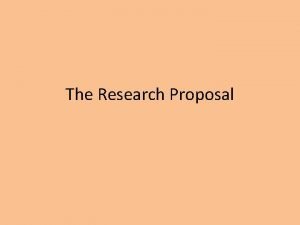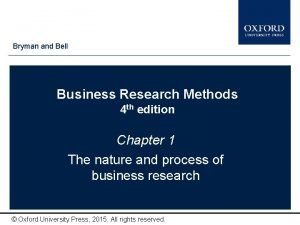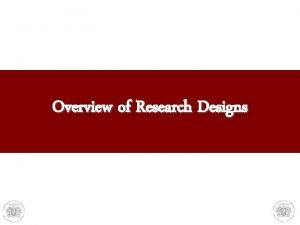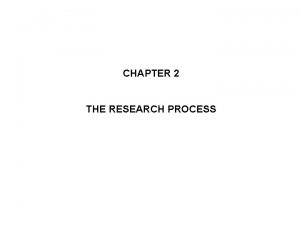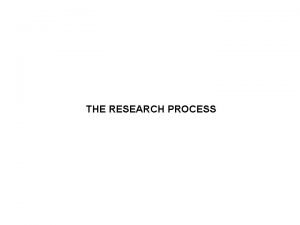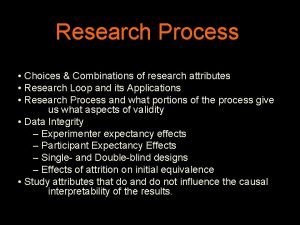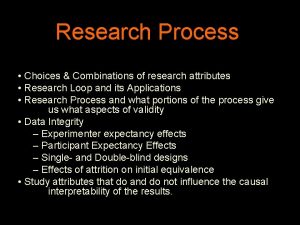Research Process Research Process n n n n


















- Slides: 18

Research Process

Research Process n n n n A research process involves the following sequence of steps: 1) Problem Definition 2) Objectives of the research 3) Research design 4) Data collection 5) Data Analysis 6) Interpretation of Results 7) Validation of results

A res. Problem must be identified and defined without the ambiguity. n Productivity is the core objective----organization for its survival. Continuous res. Is essential. Res project must be clearly defined. n

2) Objectives of the research The objectives of the research must be identified by taking the system requirements into account. n Steps: n 1) Res. Question n 2) Hypotheses n 3) Boundary of the study n

1) Res. Question are the problems which are not resolved till date n Q. should be related to a)purpose b)place c)present state of res. issue d)Means of finding sol. n Ans. of these Q. will provide a starting point to crystallize the objective and hypotheses. n

2) Hypotheses It is an assumption about a population of the study. n 3) Boundary of the study: should be clearly defined because of its size, complexities and constraints. n

Objective of Res. 1)Quantitative 2)Qualitative n 1)Quantitative Objectives: aim to measure of performances of the system of study. e. g A study to estimate the demand of a product with a high precision. n A study on training methods to maximize the productivity of system n

2) Qualitative Objectives: aims to test the significance of hypotheses of study of impottance. e. g. n A study on testing the effect of cultural change on national economy n -------------------level of education of sales force of a company on its sales revenue. n

3) Research design After the identification of res. Project –next stage is to design the project. n Steps: n Selection of res. Approach n Design of sampling plan n Design of experiment n Design of questionnaire n

1) Selection of res. Approach Type of res. Exploratory n. conclusive, n Modelling 2) Design of sampling plan n Sampling plan is a mechanism by which the sampling units of a study are selected from the sampling frame of the population. It effects on the cost and time to conduct the study, so it should be selected with utmost care. n

Types: 1) Probability sampling plan: n Simple random sampling n Cluster sampling, Multi stage sampling n 2) Non probability sampling plan n Judgment sampling n Quota sampling n

3) Design of experiment n n n A study involves different response variables. Each response variable may be affected by several factors. There are two main steps: a) Identify the response variables of the study b) For each response variable, repeat these steps 1) Identify the factors affecting the response variable 2) Fix the number of levels (treatments) 3) Make the skeleton of experiment

4) Design of Questionnaire: n Data can be classified into 1) Primary Data 2) Secondary Data 1) Primary data: First time by observation method, personal interview, telephone and mail survey. Success of survey depends upon strength of questionnaire. n Steps of designing questionnaire: n 1) Identification of res. Issue 2) For each issue, formulation of a set of question 3) Deciding Q. wording 4)Arrangement of Q. in appropriate sequence and format of questionnaire 4)Pre –testing questionnaire 5)Review of questionnaire for improvements. n

4) Data Collection n Data are the basic input to any decision making process in any organization. 1) Primary 2) Secondary Data: Internal and external sources 1) internal sources: sales records, marketing activity, cost information 2) External sources : Govt. publication, journals, books, magazines, newspaper, annual and res. Report.

5) Data Analysis After data are collected proper tools and techniques should be used for classification and analysis of data. n Tools are: 1) Frequency distribution 2) Cumulative Frequency distribution n 3) Relative Frequency distribution 4) Charts are graphical representation of data , Bar charts, Pie charts, histogram, Frequency curve etc. n Steps; n

n n 1) Computation of statistics i. e. mean, mode, median, standard deviation, coefficient of variation, coefficient of skewness. 2) Designing regression equation 3) Performing correlation analysis 4) Testing different hypotheses relating to various issues. 5) Factor analysis 6) discriminate analysis 7) conjoint analysis

6) Interpretation of Results: n The analysis of data yields a set of results in the form of stat. or in the form of rejection or acceptance of hypotheses.

7) Validation o Results The results must be validated by using past data. n It ensures the credibility of results. n
 Research report vs research proposal
Research report vs research proposal Site:slidetodoc.com
Site:slidetodoc.com Appendices in research
Appendices in research Research design definition
Research design definition Difference between applied research and basic research
Difference between applied research and basic research Qualitative research plan
Qualitative research plan Contrast applied research and basic research
Contrast applied research and basic research Define the research problem
Define the research problem Research instrument in experimental research
Research instrument in experimental research Longitudinal research and cross sectional research
Longitudinal research and cross sectional research Correlational research definition
Correlational research definition Parts of research chapter 3
Parts of research chapter 3 Examples of applied research
Examples of applied research Bryman bell
Bryman bell What is reseach?
What is reseach? Quantitative vs. qualitative
Quantitative vs. qualitative Practical research inquiry
Practical research inquiry Cross sectional vs longitudinal
Cross sectional vs longitudinal Exploratory research types
Exploratory research types
